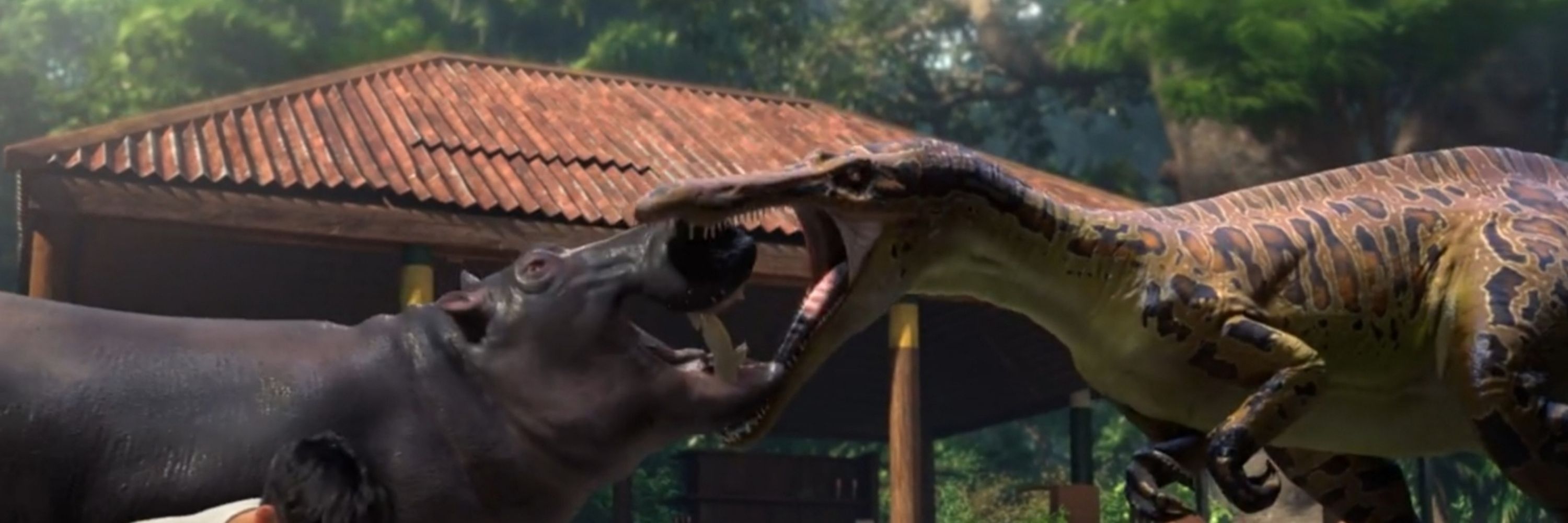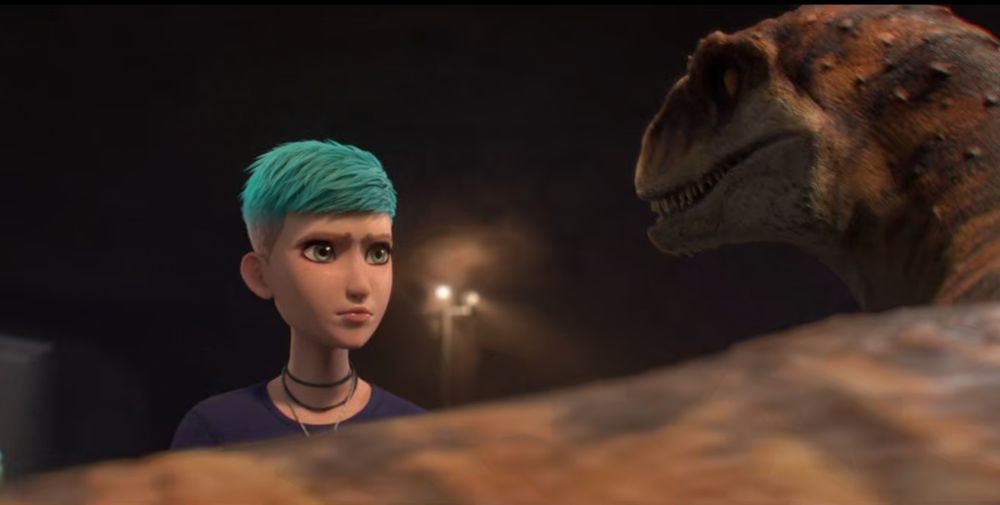
CEO of the Camp Cretaceous fanclub
LGBTQ+, Persian
From Early to Middle Pleistocene Eurasia, the steppe mammoth is one of the largest species, with some giant specimens reaching in excess of 11 tons. Likely covered in fur, it marked the initial adaptation of mammoths to cold climates
Art by Beth Zaiken


From Early to Middle Pleistocene Eurasia, the steppe mammoth is one of the largest species, with some giant specimens reaching in excess of 11 tons. Likely covered in fur, it marked the initial adaptation of mammoths to cold climates
Art by Beth Zaiken

Huge thanks to Dreamworks for letting me watch this early 🦖
YT: t.co/g9TFFBLICY
Audio: t.co/QaROFBIrKE

Huge thanks to Dreamworks for letting me watch this early 🦖
YT: t.co/g9TFFBLICY
Audio: t.co/QaROFBIrKE
🦖 Our review: youtu.be/QjW1-imZij8?...

🦖 Our review: youtu.be/QjW1-imZij8?...
What the eagle sized, four winged Changyuraptor lacks in bulk, it makes up for with numbers and flight. Don't fall for their elegant angelic looks; the only warmth their embrace brings is your oozing blood 🩸 ❄️

What the eagle sized, four winged Changyuraptor lacks in bulk, it makes up for with numbers and flight. Don't fall for their elegant angelic looks; the only warmth their embrace brings is your oozing blood 🩸 ❄️
Do you like how the story is tieing into Dominion?




Do you like how the story is tieing into Dominion?
From Miocene to Late Pleistocene Australia, "dreamtime serpent" was a genus of non-venomous, constricting madtsoiid snake up to 6 meters long. It would ambush kangaroos and wallabies near water, though its prey size was limited by its small head
Art by Emily Stepp


From Miocene to Late Pleistocene Australia, "dreamtime serpent" was a genus of non-venomous, constricting madtsoiid snake up to 6 meters long. It would ambush kangaroos and wallabies near water, though its prey size was limited by its small head
Art by Emily Stepp
How do you think these little guys were handled in CT?




How do you think these little guys were handled in CT?
From Middle Pleistocene to Holocene Eurasia and North Africa, the auroch was the wild ancestor to modern domestic cattle, growing to 1.8 meters tall at the shoulder with 80cm horns. It had an athletic build with an elongated skull


From Middle Pleistocene to Holocene Eurasia and North Africa, the auroch was the wild ancestor to modern domestic cattle, growing to 1.8 meters tall at the shoulder with 80cm horns. It had an athletic build with an elongated skull
How far would you go if you were in Brooklynn's shoes? 🦖




How far would you go if you were in Brooklynn's shoes? 🦖
From Late Pleistocene to Holocene North Pacific, Steller's Sea Cow was the largest sirenian at up to 8 tons. A surface dweller, it had white bristles on its upper lip and two keratin plates in its mouth instead of teeth for chewing kelp


From Late Pleistocene to Holocene North Pacific, Steller's Sea Cow was the largest sirenian at up to 8 tons. A surface dweller, it had white bristles on its upper lip and two keratin plates in its mouth instead of teeth for chewing kelp
It's a heartbreaking one, this. We'd love to know what you make of it 🦖




It's a heartbreaking one, this. We'd love to know what you make of it 🦖
From Late Pleistocene Channel Islands, the pygmy mammoth decends from the Columbian mammoths who colonized the channel Islands. Around 2 meters tall at the shoulder, they became extinct as a result of envoirmental changes and the arrival of humans


From Late Pleistocene Channel Islands, the pygmy mammoth decends from the Columbian mammoths who colonized the channel Islands. Around 2 meters tall at the shoulder, they became extinct as a result of envoirmental changes and the arrival of humans
Link below! 🦖

Link below! 🦖
Give us some thoughts on this fiery episode




Give us some thoughts on this fiery episode
From Early Cretaceous Araripe Basin, Brazil, "comb mouth" is a newly described ctenochasmid filter feeding pterosaur named after its long jaws sporting bristle-like teeth. It was discovered in (checks notes) fossilized dinosaur vomit??!
Arr by Julio Lacerda


From Early Cretaceous Araripe Basin, Brazil, "comb mouth" is a newly described ctenochasmid filter feeding pterosaur named after its long jaws sporting bristle-like teeth. It was discovered in (checks notes) fossilized dinosaur vomit??!
Arr by Julio Lacerda
What are your thoughts on Season 3's third episode? 🦖




What are your thoughts on Season 3's third episode? 🦖
From Late Pleistocene to Holocene New Zealand, "terrible bird" is the largest genus of moa, with females estimated up to 3.6 meters tall and the males being much smaller. They laid giant eggs the size of a rugby ball with a very thin shell


From Late Pleistocene to Holocene New Zealand, "terrible bird" is the largest genus of moa, with females estimated up to 3.6 meters tall and the males being much smaller. They laid giant eggs the size of a rugby ball with a very thin shell








What was your first impression of Gia and Nonna?




What was your first impression of Gia and Nonna?
Check out the teaser for "Calon Arang", a supernatural horror short featuring an entity that takes the form of a Maip. Link below

Check out the teaser for "Calon Arang", a supernatural horror short featuring an entity that takes the form of a Maip. Link below
From Pliocene to Early Pleistocene Eurasia, Africa, and (uniquely for a hyena) North America, "Canyon's Destroyer" is a genus of hyena that evolved a cursorial, canid-like lifestyle rather than the usual bone crushing morphology


From Pliocene to Early Pleistocene Eurasia, Africa, and (uniquely for a hyena) North America, "Canyon's Destroyer" is a genus of hyena that evolved a cursorial, canid-like lifestyle rather than the usual bone crushing morphology
Is this a good start to Season 3?




Is this a good start to Season 3?
From Late Pleistocene to Holocene New Zealand, Haast's Eagle is the largest known true eagle, with females estimated at up to 18kg. Its large size is an evolutionary response to its favorite prey, the 200kg moa
Art by Julio Lacerda


From Late Pleistocene to Holocene New Zealand, Haast's Eagle is the largest known true eagle, with females estimated at up to 18kg. Its large size is an evolutionary response to its favorite prey, the 200kg moa
Art by Julio Lacerda

